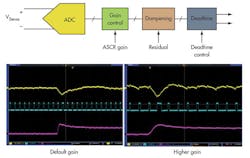In November, Intersil announced a new family of power management ICs, including a highly integrated, digital dc-dc power controller with what it calls a “ChargeMode” control loop technology. ChargeMode eliminates control loop compensation from the design process. The ZL8800 enables fast transient response without compensation, reducing design time. And thanks to its excellent transient response, it reduces output capacitor size and board space, according to the company.
This file type includes high resolution graphics and schematics when applicable.
Target systems typically require control and monitoring of every power rail to maximize reliability. System designers use external monitors and sequencers to provide the added functionality around the point-of-load converters (PoLs). The ZL8800 integrates all of those functions and provides for control through the industry-standard PMBus interface. Telemetric data on the power supply includes temperature, input current, output current, input voltage, and output voltage.
ZL8800 output can operate independently, or it can be paralleled, with split phases, to supply higher current levels. Output voltages can range from 0.54 to 5.5 V. Input voltages can range from 4.5 to 14 V.
Power Navigator GUI
Intersil’s PowerNavigator user interface simplifies design with the ZL8800. Designers can use the drag-and-drop utility to set up and control any power supply architecture.
“Traditional digital power controllers achieve loop stability using the same pole-zero placement approach as analog control techniques, except in the digital domain they implement PID (proportional-integral-derivative). While well understood, this approach does not take advantage of the benefits offered with digital signal processing to enable stable, fast transient response power supplies,” said Chance Dunlap, senior marketing manager at Intersil.
“The proprietary ChargeMode control loop from Intersil is the first digital loop to break away from the traditional approach, utilizing digital control to its full extent. Implementing non-linear control with over-sampling of the output, a wide loop bandwidth can be obtained without excessive phase shift. In addition, a unique digital convergence approach ensures that the loop remains stable without the need for compensation,” Dunlap said.
“With Intersil’s fourth generation ChargeMode digital controller, a power supply can now be realized that offers high performance with fast design time and high reliability, while avoiding complicated compensation settings,” he said.1
History
To understand why this is a landmark product, it helps to review the evolution of PoL voltage regulation. The part of Intersil that developed the new devices used to be Zilker Laboratories. So, this announcement primarily concerns PoL dc-dc conversion using the Intermediate Bus Architecture (IBA) under a somewhat loose definition of IBA. Intersil acquired Zilker Labs in the first quarter of 2009.
Turn back the clock to 2004, when IBA was a bright and shiny new thing. Powering the arrays of cabinets filled with blade servers in data centers was a challenge. Each of the CPUs in these blade servers had three or four power rails whose current demands would switch wildly between milliamps and amps as the CPU chips switched from dormant states to full activity.
IBA distributed unregulated 48-V dc from a front end at the ac power drop to the cabinets. Inside the cabinets, each board in the system has its own step-down supply, or bus converter, that changed the front end’s 48 V to 12-, 8-, or 5-V bus voltages. Then the bus voltage was stepped down and regulated by PoL buck converters at each load. The key to making those PoLs work was abandoning the idea of analog feedback in the bus converters and going to digital control loops.
The issue of digital control created lots of controversy. During the 2004 IEEE APEC conference, there was spirited debate during the sessions of the Power Supply Manufacturers Association as to whether digital control would really work, whether anybody would pay for it, and whether design engineers at the systems-level companies would abandon their familiar analog design approaches.
This opened the door to a number of semiconductor startups that were committed to making the design of digitally controlled dc-dc converters, especially in data centers, simple and bulletproof. Early innovators included Primarion (now part of Infineon), Power-One (acquired by ABB), Silicon Laboratories, Vicor (with a proprietary alternative to IBA), and Zilker Labs (now, as noted above, with Intersil).
Each of these companies approached the market with design tools that included some kind of graphical user interface (GUI) intended to simplify, among other things, the task of compensating the voltage-control loop in the digital domain by programming PoLs without human intervention. Some of these GUIs were simple “fill in the box” screens. Others had on-screen sliders and dynamic displays of the feedback transfer function that let power supply designers develop a “feel” for potential circuit behavior.
Meanwhile, simple dc-dc PoL regulators grew more functionally complicated. With the “hard part” of the design streamlined by the GUIs and the software behind it, it became a point of product differentiation to enhance conversion efficiency across broad load-current ranges using techniques such as paralleling multiple digital PoLs while staggering their clock phases. There was also differentiation in external control buses.
Zilker Labs was one of the leaders in this aspect of power supply design, but it always did things a little differently. In 2006, it introduced a controller-less autonomous approach for multiple PoLs in which regulators in the group would turn on in order, starting with the device with the lowest address and continuing until all of the devices in the chain were on.
No device would start its turn-on routine until the previous device was in regulation. The device with the highest address would turn off first, followed in reverse order by the other devices in the group. The clock was automatic in phase-spreading, when all converters were synchronized to the same switching. The phase offset for each chip was determined by its device address. Phase offset was the device address times 45°.
In 2008, Zilker introduced PoLs that provided what the company calls adaptive compensation. The new chips then could dynamically modify loop-compensation coefficients in response to varying load conditions, without external components.
Thus, the ZL8800 and Power Navigator continue the evolution of digital power control. In another sense, they’re more than an incremental step forward, thanks to the totally compensation-capacitor-free loop control and the simplicity of the drag-and-drop user interface.
About the Author

Don Tuite
Don Tuite (retired) writes about Analog and Power issues for Electronic Design’s magazine and website. He has a BSEE and an M.S in Technical Communication, and has worked for companies in aerospace, broadcasting, test equipment, semiconductors, publishing, and media relations, focusing on developing insights that link technology, business, and communications. Don is also a ham radio operator (NR7X), private pilot, and motorcycle rider, and he’s not half bad on the 5-string banjo.


